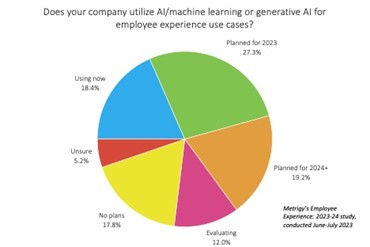I kicked off 2023 with a post titled “Employee Experience: AI on the 2023 Agenda.” As I stated then, I’d expected to see increased use of artificial intelligence (AI), across a variety of use cases, to improve employee experience (EX). I wouldn’t call myself particularly prescient, but I wasn’t wrong.
With the rise of generative AI into mainstream consciousness (thanks in large part to release of OpenAI’s ChatGPT publicly available conversational search tool), the cloak of mystery around AI has been lifted. Vendors are adding AI—generative and otherwise—to all sorts of products, and many companies are jumping on board.
In Metrigy’s Employee Experience: 2023-24 global research study, conducted in June-July 2023, 45.7% of the 499 participating companies said they were already using or planning to use AI/machine learning (ML) or generative AI for employee experience use cases in 2023. As the following chart shows, 19.2% have adoption of AI/ML planned for 2024 (or beyond) while another 12% were evaluating the technology at the time of the survey.
AI’s Top Value: Predicting Changes
For most companies (58.7%) already using AI for employee experience, the top value is the ability to predict changes in key business metrics. This is the role of traditional AI/machine learning—i.e., predicting change on a given set of data and then, optimally, act on it.
Consider, for example, the variety of AI capabilities companies could use alone or in tandem to sniff out changes in key factors such as employee satisfaction. This includes, but is not limited to:
- Survey analysis: Analyzing responses for trends or correlations that could point to specific areas that a company should address in order to improve satisfaction or another metric.
- Predictive analytics: Combining historical data, such as satisfaction ratings, with company events, such as management changes, a major product release, or strategic shift, to predict potential changes in satisfaction or another metric.
- Social network analysis: Analyzing social interactions among employees to glean insights from changes in communications patterns or group dynamics that could signal a change in satisfaction or another metric.
- Sentiment analysis: Analyzing text from email, enterprise social network or other social media posts, feedback forms, or surveys to detect attitudinal shifts that could signal decline in satisfaction.
Gather EX Data More Frequently
In our employee experience study, we also asked participants to tell us how they gather employee sentiment data for analysis. The most popular method, for two-thirds of companies, is to survey employees annually or at another set interval. This, however, does not correlate with success. Our success group, as determined by improvements in satisfaction, retention, and productivity, is to gather employee sentiment data via in-the-moment pulse polls, topical polls, and at key journey moments. For example, nearly 71% of the study’s success group gathers employee sentiment at key journey moments compared to roughly 46% of the non-success group.
And Then Act on Those Results
Unfortunately, slightly more companies are gathering and analyzing employee sentiment data than take action on it—48.8% and 44.5%, respectively. This is not acceptable. Knowing that employee satisfaction is dropping is important, but implementing change with an eye on improving ratings is imperative. Using AI, has your company discovered that employees are feeling uninformed or unrecognized? Improving employee communications or implementing a rewards and recognition program would be appropriate action items, for example. Also, following up with employees is critical. Let employees know that their voices were heard and changes implemented as a result. Today, just shy of 41% of companies circle back with employees in this way.
Gen AI’s Unique Role
Generative AI has a different role to play. When it comes to generative AI, 58.7% see content creation as the top use or potential use for their companies. In general, generative AI is touted for its ability to help in creating company marketing materials like email, newsletters, or reports, among other uses. Specifically for employee experience purposes, HR or team managers might use generative AI to create personalized polls and surveys, feedback forms, quizzes, and other interactive content. Generative AI might also come into play for creating customized learning and training modules based on an individual employee’s skills, as well as to develop personalized career roadmaps based on the employee’s aspirations.
More than half of respondents—54.3% in each case—also see opportunities for improving employee experience by allowing the use of generative AI to assist employees in note taking and to support conversational queries of HR systems. An additional 47.8% see the value in using generative AI for auto-summarization, be that of meetings, reports, performance reviews, and so on.
The Year Ahead
No doubt, in 2024 and beyond, the use of AI of all sorts will grow in importance for employee experience use cases. We can expect to see increased use by leadership to understand key employee-related performance metrics, as well as by employees, via generative AI, to improve their work processes.





